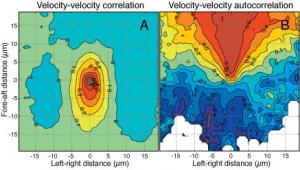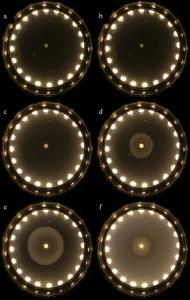
Concentrated motile bacteria spontaneously produce quasi-regular swirling patterns of motion. Similar phenomena has been observed in many systems of many sizes, the most familiar of which is probably a flock of birds. I work with swarm colonies of Escherichia coli and Bacillus subtilis, which are roughly analogous to dense, two-dimensional flocks of extremely small, stupid birds.
Swarming bacteria swim in a ~1 µm thick film of fluid on the surface of an agar plate. Like swimming bacteria, they use their flagella to produce thrust. The edge of the colony is very well defined, since any bacterium that strays beyond the interior becomes stalled on dry, uncolonized agar until colony expansion overtakes and rescues the stranded individual.
I am interested in two interrelated aspects of swarm colonies:
-
What determines the locally ordered structure of a swarm?

Velocity-velocity correlation (A) and autocorrelation (B) for cells in an E. coli swarm. Cell bodies and velocities tend to be locally aligned over a short distance scale, perhaps through collisions. On axes defined relative to the cell body (so that +y corresponds to straight ahead), the alignment is left-right symmetric but not fore-aft symmetric: correlation extends over a longer range behind the cell than in front of it. For correlations among different cells at the same time, correlations extend over no more than a few body lengths. For autocorrelations between a cell and itself at later positions, correlations extend over a longer distance in the foreward direction but fall off very sharply in other directions. What sets the scale of these correlations? Possible candidates are cell size, speed or density.
The swirling pattern looks like bioconvection. Does it, like bioconvection, increase transport within the colony? How much population exchange is there between the active outer layers of the colony and the nonmotile core?
-
What determines the expansion rate of a swarm?
 Swarms seem, after a variable delay, to expand in a well-determined way. Some strains are better swarmers, and some agar surfaces support better swarming, but no one knows exactly what properties of bacteria and surface matter. It seems that growth rate, surfactant production rate, and motility are important, while surface shape and nutrient concentration (above a critical level) are not. Some swarms exhibit fingering instabilities reminiscent of crystal growth. What determines the occurrence and size of these instabilities?
Swarms seem, after a variable delay, to expand in a well-determined way. Some strains are better swarmers, and some agar surfaces support better swarming, but no one knows exactly what properties of bacteria and surface matter. It seems that growth rate, surfactant production rate, and motility are important, while surface shape and nutrient concentration (above a critical level) are not. Some swarms exhibit fingering instabilities reminiscent of crystal growth. What determines the occurrence and size of these instabilities?
Swarming is a beautiful and biologically important example of self-organizing behavior that is well suited to the analysis tools of statistical physics.
